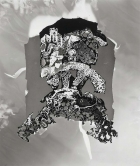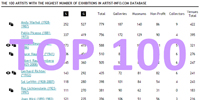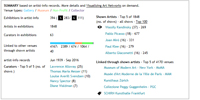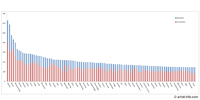
Artist | Nam June Paik (1932 - 2006)
https://www.artist-info.com/artist/Nam-june-Paik
Biography (english / deutsch)
Biography (english / deutsch)
born in Seoul (Korea) in 1932
Nam June Paik is generally recognized as the pioneer of video art. His preoccupation with the medium as an artform in its own right dates back to the early sixties, and he has had a decisive influence on younger artists working in this field.
Having studies composition under Wolfgang Fortner in Freiburg (1957/58), Paik, by now a trained musician and musical theorist, began working and experimenting with visual electronics as early as 1962. Among the best known works of this period are Zen for film (1962), which consists of a blank film showing only the pure light of the projector as well as dust and scratches on the film material itself, and Zen for TV (1963), in which the picture on the TV screen is manipulated to the point of being reduced to abstract interference, a vertical line on a television set that has been stood on its side. This was Paik’s assault an the perceptual habits of TV viewers and the flood of images generated by this kind of medium. (One is tempted to compare it with early Warhol films such as „Kiss“, „Sleep“ or „Empire“, produced in 1963/64.)
Nam June Paik gilt als der Wegbereiter der Videokunst. Seit Anfang der 60er Jahre hat er sich mit diesem Medium als eigenständiger Kunstform beschäftigt und jüngere Künstler in diesem Bereich maßgeblich beeinflußt.
Der ausgebildete Musiker und Theoretiker Paik beginnt nach seinem Kompositionsstudium bei Wolfgang Fortner in Freiburg (1957/58) bereits 1962 mit visueller Elektronik zu arbeiten und zu experimentieren. Zu den bekanntesten Werken dieser Zeit gehören Zen for film von 1962, der aus einem Klarfilm besteht, der nur das reine Licht des Projektors sowie Staub und Kratzer auf dem Filmmaterial zeigt, und Zen for TV von 1963, bei dem das Fernsehbild durch Manipulation auf ein abstraktes Störbild, eine senkrechte Linie auf einem hochkantgestellten Fernsehgerät, reduziert ist. Paik attackierte damit die Fernsehgewohnheit des Zuschauers und die Bilderflut eines solchen Mediums. (Ein Vergleich mit den frühen Warhol Filmen wie "Kiss“, "Sleep“ oder “Empire“ von 1963/ 64 liegt hierbei nahe.)
About the work (english / deutsch)
About the work (english / deutsch)
One Candle
The TV Buddha of 1974 marks the beginning of Nam June Paik’s work on „closed-circuit“ installations, incorporating a live camera linked back to a visual display unit. An antique statue of Buddha sits opposite a monitor showing the TV image of the Buddha as it is filmed by a camera. The Buddha contemplates its own image and meditates upon it. In the sculpture Candle TV (1975), an important precursor to the video installation on exhibition here, the Buddha has been replaced by the observer. A burning candle stands in the hollow shell of a 1950s TV set, which looks like an antique relic from some bygone hightech age.
And a burning candle also provides the subiect matter for One Candle (1988). Here the observer enters the room to find a candle standing on a tripod at approximately eye-level. A video camera is pointed towards it and is filming the flickering light of the flame. The camera is in turn hooked up to four video projectors which transfer the image simultaneously - or so it appears to the human eye - onto the walls of the exhibition room. Thus we are a witness to the synchronous coexistence of image and reality, the coincidence of natural and artificial light. The technical equipment is clearly visible in the room, so that the observer is easily able to discover how the image is being produced.
The result is a non-material, electronic image with the walls acting as projection surfaces. The enlarged colour image of the slightly flickering candle-flame fills the room with movement. The video picture shows an image which, unlike a roll off film, can never be reproduced. The tubes of the video projectors are like the tubes of colour aqueezed onto the artist’s palette, with red, blue, green, and their various combinations. They remind us of Bengal lights. The three basic video colours are not tuned to coincide with each other in the usual manner, but have been deliberately not centred and are left out of balance, so that a triple image of the candle-flame appears on each of the walls.
The artificial coolness of the electronics and the strong colours of the image contrast with the warm natural light of the candle. In this work, Paik has created a unity of opposites. In his own words: "I love anti-technological technology." In fact, Paik is able to transcend technology by using it in this precise but simple way.
The Asian mentality, with its heightened awareness of the inconspicuous and simple, stands in stark contrast to the western world’s technological perfection as witnesses in its brightly coloured flood of images. The high-tech video installation is, moreover, still dependent on candlelight - if we snuffed out the candle, the video image would disappear along with it. All that would remain would be darkness: and it is a darkness in the sense of our cosmic relationship to the universe.
There is something fluid and transient about the burning of a candle. In 17th century Dutch stilllife, for example, the candle was always seen as a symbol of vanity, mirroring human life. And in Christian iconography in Europe the light in the darkness stands for Christ. Yet there is no gloomy, moralizing symbolism in this room: the mood here is tender and cheerful. As a Korean artist, Nam June Paik has been strongly influenced by Zen Buddhism, and in particular by its meditative and philosophical thrust. And this work contains an element of sound, namely silence. (The early influence of John Cage’s work deserves mention in this context.) The result is an almost religious space, a space filled with timelessness - movement in space and time.
Paik has recently experimented with large-scale multi-monitor installations of gigantic proportions involving several video tapes and use of the latest computerized cutting techniques. In One Candle, the reduction of his materials to a minimum now signifies a return to the strict minimalism of his early works.
German text by Mario Kramer / Translation by Jeremy Gaines
(Extract - Full printed version available in the Museum)
MMK - Museum für Moderne Kunst, Frankfurt am Main
One Candle
Mit dem TV Buddha beginnt Nam June Paik 1974 mit den 'Closed-Circuit’-Installationen (geschlossener Kreislauf von Live-Kamera und Wiedergabegerät.) Eine antike Buddhastatue sitzt einem Monitor gegenüber, der das von einer Kamera aufgenommene Fernsehbild des Buddhas zeigt. Der Buddha betrachtet sein eigenes Abbild und meditiert darüber. In der Skulptur Candle TV (Kerzen TV) von 1975, ein wichtiger Vorläufer der hier gezeigten Video-Installation, rückt der Betrachter an die Stelle des Buddha. In einem entkernten Fernsehgehäuse aus den 50er Jahren, das wie ein antikes Relikt aus einer vergangenen hochtechnisierten Zeit erscheint, brennt eine aufgestellte Kerze.
Im Ausstellungsraum mit der Arbeit One Candle von 1988 steht eine brennende Kerze, ungefähr in Augenhöhe des Betrachters, auf einem Stativ. Eine Video-Kamera ist auf die Kerze gerichtet und filmt das Flammenlicht. Die Kamera wiederum ist direkt an die vier Video-Projektoren angeschlossen, die das Abbild, zeitgleich für das menschliche Auge, an die Wände des Ausstellungsraums werfen. Bild und Realität laufen synchron - Koinzidenz von Natur und Kunstlicht. Das technische Equipment steht sichtbar im Raum. Die Bild-Produktion ist für den Betrachter leicht nachvollziehbar.
Es entsteht ein immaterielles, elektronisches Bild, wobei die Wände zu Projektionsflächen werden. Der Ausstellungsraum ist voller Bewegung durch das farbig reproduzierte und vergrößerte Bild des leicht flackernden Kerzenlichts. Das Video-Bild zeigt ein nicht reproduzierbares Bild, also keine Filmkonserve. Die Farbpaletten sind die Bildröhren der Video-Projektoren: Rot, Blau, Grün und ihre Mischfarben. Sie erscheinen wie bengalisches Licht. Die drei Video-Grundfarben sind nicht wie üblich deckungsgleich aufeinander justiert, sie sind vielmehr bewußt versetzt, sogar gekippt zu einander eingestellt, so daß die Kerzenflamme jeweils dreimal erscheint.
Die artifizielle Kühle der Elektronik, die Buntheit der Bilder, kontrastieren mit dem warmen natürlichen Licht der Kerze. Paik verknüpft in diesem Werk Gegensätze. „Ich liebe die anti-technologische Technologie.“(Paik) Eigentlich überwindet Paik die Technologie durch ihren sehr präzisen, aber simplen Einsatz.
Die Aufmerksamkeit für das Unscheinbare, Einfache der asiatischen Mentalität steht der technisch perfekten bunten Bilderflut der westlichen Welt gegenüber. Die hochtechnische Anlage der Videoinstallation ist zudem abhängig vom Kerzenlicht, sobald dieses erlischt, verschwindet auch das Video-Bild. Der Rest wäre Dunkelheit, auch im Sinne des kosmischen Bezugs zum Universum.
Dem Brennen der Kerze wohnt etwas Fließend-Vergängliches inne. In der niederländischen Stilllebenmalerei des 17. Jahrhunderts z.B. galt die Kerze von jeher als Vanitas-Bild, als Spiegel- und Sinnbild des menschlichen Lebens. Schließlich steht in der christlich-europäischen lkonographie das Licht in der Finsternis für Christus. Aber nicht die düstere, moralisierende Symbolik, sondern vielmehr eine zarte, heitere Stimmung herrscht in diesem Raum. Der koreanische Künstler Nam June Paik ist vor allem durch das meditative philosophische Moment des Zen-Buddhismus geprägt. Als klangliches Element beinhaltet dieses Werk die Stille. (Der frühe Einfluß des Schaffens von John Cage soll an dieser Stelle nicht unerwähnt bleiben.) Es entsteht ein fast sakraler Raum. Ein Raum der Zeitlosigkeit - Bewegung in Raum und Zeit. Nach der Vielzahl von großflächigen Multi-Monitor-Installationen von gewaltigem Ausmaß mit mehreren Videobändern und unter Zuhilfenahme von neuesten Schnittcomputern reduziert Paik in diesem Werk One Candle seine Mittel auf ein Minimum und kehrt damit zu seinen strengen, minimalistischen Arbeiten des Frühwerks zurück.
Text von Mario Kramer
(Auszug - Der vollständige Text ist als Informationsblatt beim Museum erhältlich)
MMK - Museum für Moderne Kunst, Frankfurt am Main
Solo Exhibitions (selection)
Solo Exhibitions (selection)
1996 Nam June Paik, Galerie Asbæk, Copenhagen, Denmark
1995 Nam June Paik Video Sculptures and Video Installations, Ars Nova, Turku, Finland
1995 The Electronic Superhighway, Holly Solomon Gallery, New York, USA
1994 The Electronic Super Highway: Nam June Paik in the Nineties, Ft. Lauderdale
1994 Museum of Art, Florida and other Museums, USA
1993 Nam June Paik Eine Data Base, German Pavillion, La Biennale di Venezia, Venice, Italy
1992 Nam June Paik: Retrospective, Museum des 20. Jahrhunderts, Vienna, Austria
1992 Electro-Symbio Phonics for Phoenix, Public Art Commission, American West Arena Phoenix, USA; Casino Knokke, Belgium
1992 Nam June Paik: Retrospective, Museum of Modern Art, Seoul, Korea
1992 Nam June Paik: Arti Elettronische, Cinema e Media Verso il XXI Seculo, Palazzo delle Esposizioni, Rome, Italy
1991 Nam June Paik: Retrospective, Kunsthaus Zürich; Kunsthalle Basel, Switzerland
1989 La Fée Electronique, Musée d’Art Moderne de la Ville de Paris, Paris, France
1989 Image World: Art and Media Culture, Whitney Museum of American Art, New York, USA
1988 Nam June Paik: Beuys and Bogie, Dorothy Goldeen Gallery, Los Angeles, USA
1988 Nam June Paik: Family of Robot, The Hayward Gallery, South Bank Centre, London, UK
1986 Nam June Paik: Sculpture, Painting and Laser Photography, Holly Solomon Gallery, New York, USA
1985 Nam June Paik: Family of Robot, Carl Solway Gallery, Cincinnati; International Art Exposition, Chicago, USA
1982 Nam June Paik, Whitney Museum of American Art, New York; Museum of Contemporary Art, Chicago, USA
1982 Tri-Color Video, Centre National d’Art et de Culture Georges Pompidou, Paris, France
1981 Random Access/Paper TV, Gallery Watari, Tokyo, Japan
1978 TV Garden, Centre National d’Art et de Culture Georges Pompidou, Paris, France
1978 Nam June Paik, Musée d’Art Moderne de la Ville de Paris, France
1976 Nam June Paik: Werke 1946-1976, Music-Fluxus-Video, Kölnischer Kunstverein, Cologne, Germany; Stedelijk Museum, Amsterdam, Holland
1976 Projects: Nam June Paik, Museum of Modern Art, New York, USA
1974 Electronic Art IV, Galeria Bonino, New York, USA
1974 Fish on the Sky - Fish hardly flies anymore on the Sky - Let Fishes fly
again, Martha Jackson Gallery, New York, USA
1971 Electronic Art III, Galeria Bonino, New York, USA
1971 Cineprobe (films in collaboration with Jud Yalkut), Millennium Film Workshop, New York, USA
1968 Electronic Art II, Galeria Bonino, New York, USA
1965 NJ Paik: Electronic TV, Color TV Experiments, 3 Robots, 2 Zen Boxes, and 1 Zen Can, New School for Social Research, New York, USA
1965 Electronic Art, Galeria Bonino, New York, USA
1963 Exposition of Music - Electronic Television, Galerie Parnass, Wuppertal, Germany
Group Exhibitions (selection)
Group Exhibitions (selection)
1997 Münster Sculpture Projects, Münster, Germany
1996 Electronic Undercurrents: Nam June Paik Video Scukptures, Statens Museum for Kunst, Copenhagen, Denmark
1995 3ème Biennale de Lyon, Musée d’Art Contemporain, Lyon, France
1993 ARCO 1993, Madrid, Spain
1992 Flux Attitudes, New Museum of Contemporary Art, New York, USA
1992 Nam June Paik: Video and Paper with Allen Ginsberg, Gallery Meegun, Seoul, Korea
1989 Image World: Art and Media Culture, Whitney Museum of American Art, New York, USA
1989 Video Sculpture, retrospektiv und aktuell, 1963-1989, DuMont Cologne, Germany
1989 Nam June Paik, San Francisco Museum of Art, San Francisco, USA
1988 Video Art: Expanded Forms, Whitney Museum of American Art at Equitable Center, New York, USA
1987 Documenta 8, Kassel, Germany
1987 Biennial Exhibition, Whitney Museum of American Art, New York, USA
1984 XLI Exposizione Internazionale la Biennale di Venezia, Venice, Italy
1984 The Luminous Image, Stedelijk Museum, Amsterdam, Holland
1984 Nam June Paik, John Cage, Merce Cunningham, Won Gallery, Seoul, Korea
1984 Joseph Beuys and Nam June Paik, Gallery Watari, Tokyo, Japan
1982 Videokunst in Deutschland 1963-1982, Kölnischer Kunstverein, Cologne, Germany
1982 Wiesbaden FLUXUS 1962-1982, Eine kleine Geschichte von Fluxus in drei Teilen, Wiesbaden, Kassel, Berlin, Germany
1981 Biennial Exhibition, Whitney Museum of American Art, New York, USA
1977 Documenta 6, Kassel, Germany
1977 Biennial Exhibition, Whitney Museum of American Art, New York, USA
1975 Video Art, Institute of Contemporary, University of Pennsylvania; Chicago Art Institute, USA
1975 Art Transition, Center for Advanced Visual Studies, Massachusetts Institute of Technology, Cambridge, USA
1974 Project 74: Aspekte Internationaler Kunst am Anfang der 70er Jahre, Kunsthalle Köln and Kölnischer Kunstverein, Cologne, Germany
1973 Circuit: A Video Invitational, Everson Museum of Art, Syracuse, USA
1971 Videoshow, The New American Film-makers Series, Whitney Museum of American Art, New York, USA
1970 Vision and Television, Rose Art Museum, Brandeis University, Massachusetts, USA
1970 Happening and Fluxus, Kölnischer Kunstverein, Cologne, Germany
1969 Electronic Art, Art Gallery, University of California, Los Angeles, USA
1969 TV as a Creative Medium, Howard Wise Gallery, New York, USA
1968 The Machine: As Seen at the End of the Mechanical Age, Museum of Modern Art, New York, USA
1967 Light, Motion, Space, Walker Art Center, Minneapolis, USA
1966 Programmed Art, Museum of Art, Rhode Island School of Design, Providence, USA
1966 Art Turns On, Institute of Contemporary Art, Boston, USA
 offers / Requests offers / Requests  |
Learn more about this service |
|---|
 Exhibition Announcements Exhibition Announcements  |
About this service |
|---|
 Visualization |
Learn more about this service | ||
|---|---|---|---|

Interested in discovering more of this artist's networks?
3 easy steps: Register, buy a package for a visualization, select the artist.
See examples how visualization looks like for an artist, a curator, or an exhibition place: Gallery, museum, non-profit place, or collector.

Exhibition History

|
SUMMARY based on artist-info records. More details and Visualizing Art Networks on demand. Venue types: Gallery / Museum / Non-Profit / Collector |
||||||||||||
| Exhibitions in artist-info | 266 (S 51/ G 215) |
Did show together with - Top 5 of 4290 artists (no. of shows) - all shows - Top 100
|
||||||||||
| Exhibitions by type | 266: 65 / 116 / 81 / 4 | |||||||||||
| Venues by type | 182: 47 / 73 / 58 / 4 | |||||||||||
| Curators | 172 | |||||||||||
| artist-info records | Jun 1962 - Mar 2024 | |||||||||||
|
Countries - Top 5 of 18 Germany (96) United States (85) France (17) Switzerland (10) Korea (7) |
Cities - Top 5 of 95 New York (55) Berlin (21) Köln (11) Frankfurt am Main (8) München (7) |
Venues (no. of shows )
Top 5 of 182
|
||||||||||
Curators (no. of shows)
Top 5 of 172
|

Glitch - Die Kunst der Störung |
||||||
| Pinakothek der Moderne | G | Dec 2023 - Mar 2024 | München | (62) | +0 | |
| Kunze, Franziska (Curator) | +0 | |||||
| Bauer, Franziska (Curator) | +0 | |||||

ZERO, Pop und Minimal - Die 1960er und 1970er Jahre |
||||||
| Von der Heydt-Museum | G | Apr 2022 - Jul 2023 | Wuppertal | (131) | +0 | |
| Bruns, Anika (Curator) | +0 | |||||
| Eickhoff, Beate (Curator) | +0 | |||||

Before Projection - Video Sculpture 1974–1995 |
||||||
| SculptureCenter Long Island | G | Sep 2018 - Dec 2018 | Long Island City | (121) | +0 | |

Before Projection - Video Sculpture 1974–1995 |
||||||
| MIT List Visual Arts Center | G | Feb 2018 - Apr 2018 | Cambridge | (261) | +0 | |
| Huldisch, Henriette (Curator) | +0 | |||||

Parapolitik - Kulturelle Freiheit und Kalter Krieg |
||||||
| Haus der Kulturen der Welt - HKW | G | Nov 2017 - Jan 2018 | Berlin (Tiergarten) | (23) | +0 | |
| Franke, Anselm (Curator) | +0 | |||||
| Guevara, Paz (Curator) | +0 | |||||
| Ghouse, Nida (Curator) | +0 | |||||
| Majaca, Antonia (Curator) | +0 | |||||

Auto Vision - Medienkunst von Nam June Paik bis Pipilotti Rist |
||||||
| Kunsthalle Bremen | G | Apr 2017 - Sep 2017 | Bremen | (193) | +0 | |
| Grunenberg, Christoph (Curator) | +0 | |||||
| Schrage, Lena (Curator) | +0 | |||||
| Keep reading |







































